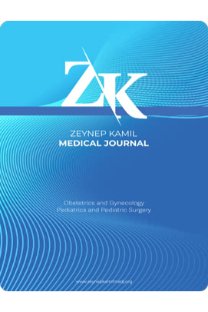Testis ve gonad biyopsisini nasıl alıyorsunuz?
What is your technique in biopsy of gonad or testis? A study of enquiry
Gonads, Testis, Questionnaires, Biopsy, Child, Diagnostic Techniques and Procedures,
___
- Aaranson IA: True hermaphroptidisim. A review of 41 cases with observations on testicular histology and function. Br J Urol 57: 775-779, 1985 Arda IS, Ozyaylalı I: Testicular tissue bleeding as an indicator of gonadal salvage ability in testicular torsion surgery. BJU Int 87: 89-92, 2001 Ashcraft KW, Holder TM: Pediatric Surgery
- Mexico, WB. Sanders 1993, p: 745 Çiftci AO, Bingol-Kologlu M, Senocak ME, Tanyel FC, Buyukpamukcu M, Buyukpamukcu N: Testicular tumors in children. J Pediatr Surg 36: 1796-1801, 2001 Dieckmann KP, Classen J, Loy V: Diagnosis and management of testicular intraepithelial neoplasia (carcinoma in situ) - surgical aspects. APMIS, 111: 64-68, 2003 Dieckmann KP, Heinemann V, Frey U, Pichlmeier U: Haw harmful is contralateral testicular biopsy? An analysis of serial imaging studies and a prospective evaluation of surgical complications
- Eur Urol , ful 8, Epub ahead of print, 2005 Dieckmann KP, Loy V: False-negative biopsies for the diagnosis of testicular intraepitelial neoplasia (T.N) -An update. Eur Urol 43: 516-521, 2003 Freeman NV, Burge DM, Griffiths DM, Malone PSJ: Sugery of the Newborn. New York. Churchill Livingstone 1994, p: 781 Hadziselimovic F: Cryptorchidism. Basel
- Springer-Verlagl983 Harland Sf, Cook PA, Fossa SD, Horwich A, Mead GM, Parkinson MC, RoberisJT, Stenning SP: Intratubular germ cell neoplasia of the contralateral testis in testicular cancer: Definnig a high risk group. Jurol 160: 1353-1357, 1998 Harrington TG, Schauer D, Gilbert BR: Percutaneous testis biopsy: An alternative to open testicular biopsy in the evaluation of the subfertile man. J Urol 156: 1647-1651, 1996 Heindreich A, Moul JW: Contralateral testicular biyopsy procedure in patients with unilateral testis cancer: Is it indicated? Semin Urol Oncol 20: 234- 238, 2002 Herr HW, Sheinfeld J: Is biopsy of the contralateral testis necessary in patients with germ cell tumors? J Urol 158: 1331-1334, 1997 Hinman FJr: Atlas ofUrologic Surgery. Philadelphia, Pennsylvania. WB.Sanders 1989, p: 304 Kelalis PP, King LR, Belman AB: Clinical Pediatric Urology, Volume II. Philadelphia, Pennsylvania. WB.Sanders 1992, p: 987, 993 LibertinoJ A: Pediatric and Adult Reconstructive Urologic Surgery. Baltimore. Williams&Wilkins, 1987, p: 620 O'Donnell B, Koff SA: Pediatric Urology The University Press, Cambridge. Butterworth Heinemann 1997, p: 689, 756 O'Neill JA, fr, Rowe Ml, Grosfeld JL, Fonkalsrud EW, Coran AG : Pediatric Surgery, Volume II
- St.Louis, Missouri. Mosby-Year Book 1998, p: 1797 Parkinson MC, Swerdlow AJ, Pike MC: Carcinoma in situ in boys with criptorchidism: When can it be detected? Br J Urol 73: 431-435, 1994 Rassweiler JJ, Seemann O,Henkel TO, Stock C, Frede T, Alken P: Laparoscopic retroperitoneal lymph node dissection for nonseminomatous germ cell tumors: Indications and limitations. J Urol 156: 1108-1113, 1996 Shukla AR, Woodard C, Carr MC, Huff DS, Canning DA, Zderic SA, Kolon IF, Sneider HM 3rd: Experience with testis sparing surgery for testicular teratoma. J Urol 171: 161-163, 2004 Steiner H, Holtl L, Manenchg C, Berger AP, Rogatsch H, Bartsch G, Hobisch A: Frozen section analysis -guided organ- sparing approach in testicular tumors: Tecnique, feasility, and long-term results. Urology 62: 508-513, 2003 Sterngerg F: Diagnostic Surgical Pathology
- Philadelphia, Pennsylvania. Lipincott Raven 1996, p: 1956, 1957,1963 Wiersma R: Management of the African Child with true hermaphrotidism. J Pediatr Surg 36: 397- 399, 2001
- ISSN: 1300-7971
- Yayın Aralığı: 4
- Başlangıç: 1969
- Yayıncı: Ali Cangül
Villoglandüler adenokarsinoma: Diagnostik ikilem
Ayşe GÜRBÜZ, Berna HALİLOĞLU, Ateş KARATEKE, Canan KABACA, Gözde KIR
Pediatrik Hodgkin hastalığı'nda CRP'nin önemi
Gülnur TOKUÇ, Sedat ÖKTEM, Şihmir ŞİMŞEK, Serdar YILMAZ
Testis ve gonad biyopsisini nasıl alıyorsunuz?
Ayşenur CELAYİR, MEHMET ELİÇEVİK, Serdar SANDER
Duras Gönül DOYRAN, İSMAİL ÖZDEMİR, Aslı SOMUNKIRAN, Kemik Özlem GÜL, Fuat DEMİRCİ, Oğuz YÜCEL
Arteryal karaciğer kanamalarında acil transkateteryal arteryal embolizasyonun yararlılığı
Savaş DEMİRBİLEK, Ramazan KUTLU
14 years experience in delayed acute scrotum from a maternal and child hospital
Serdar SANDER, MEHMET ELİÇEVİK, Murat ÜNAL, Cerrah Ayşenur CELAYİR
Liken sklerozus zemininden gelişen vulva karsinomu: Olgu sunumu
Ümmühan KİREMİTÇİ, Şerife Günel KARAGÜLLE, Turgut Aslı ERDEMİR, Elif TOPÇU, Serpil BOZKURT, Melin Özgün GEÇER, Erol BOZKURT
Ektopik gebelik: 225 olgunun incelenmesi
HAKAN PEKER, Ayşe GÜRBÜZ, Ali GEDİKBAŞI, Murat MENGÜLLÜOĞLU, Ateş KARATEKE
Ayaktan antibiyoterapi ile tedavi edilen bir renal apse olgusu
Ayhan SÖĞÜT, Sevde USLU, İbrahim ADALETLİ, Murat ELEVLİ
Özdemir Nagehan BARIŞIK, Hallaç Sevinç KESER, Mine ÇAYIRCI, CEM CAHİT BARIŞIK, Nimet KARADAYI, Bülent KARS
